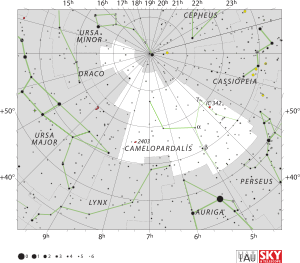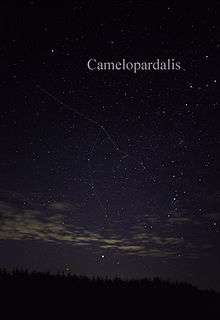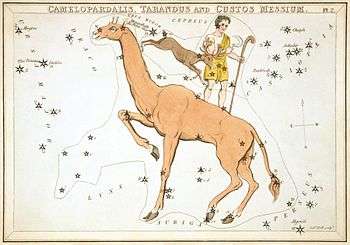Camelopardalis
| Constellation | |
 | |
| Abbreviation | Cam[1] |
|---|---|
| Genitive | Camelopardalis[1] |
| Pronunciation | /kəˌmɛləˈpɑːrdəlɪs/, genitive the same |
| Symbolism | Giraffe[1] |
| Right ascension | 03h 15m 36.2232s–14h 27m 07.8855s[2] |
| Declination | 86.0975418°–52.6655540°[2] |
| Area | 757 sq. deg. (18th) |
| Main stars | 2, 8 |
| Bayer/Flamsteed stars | 36 |
| Stars with planets | 4 |
| Stars brighter than 3.00m | 0 |
| Stars within 10.00 pc (32.62 ly) | 3 |
| Brightest star | β Cam (4.03m) |
| Messier objects | 0 |
| Meteor showers | October Camelopardalids |
| Bordering constellations |
Draco Ursa Minor Cepheus Cassiopeia Perseus Auriga Lynx Ursa Major |
|
Visible at latitudes between +90° and −10°. Best visible at 21:00 (9 p.m.) during the month of February. | |
Camelopardalis /kəˌmɛləˈpɑːrdəlɪs/ is a large but obscure constellation of the northern sky representing a giraffe. The constellation was introduced in 1612 (or 1613) by Petrus Plancius. Some older astronomy books give Camelopardalus or Camelopardus as alternative spellings of the name, but the official version recognized by the International Astronomical Union is Camelopardalis.[1]
Etymology
First attested in English in 1785, the word camelopardalis comes from Latin,[3] and it is the romanization of the Greek "καμηλοπάρδαλις" meaning "giraffe",[4] from "κάμηλος" (kamēlos), "camel"[5] + "πάρδαλις" (pardalis), "leopard",[6] due to its having a long neck like a camel and spots like a leopard.
Features

Stars
Although Camelopardalis is the 18th largest constellation, it is not a particularly bright constellation, as the brightest stars are only of fourth magnitude. In fact, it only contains four stars below (brighter than) magnitude 5.0.[7]
- α Cam is a blue-hued supergiant star of magnitude 4.3, 5000 light-years from Earth. It is one of the most distant stars easily visible with the naked eye.[1]
- β Cam is the brightest star in Camelopardalis with an apparent magnitude of 4.03. This star is a double star, with components of magnitudes 4.0[8] and 8.6. The primary is a yellow-hued supergiant 1000 light-years from Earth.[1]
- 11 Cam is a star of magnitude 5.2, 650 light-years from Earth. It is very close to magnitude 6.1 12 Cam, also 650 light-years from Earth, but the two stars are not a true double star because of their separation.[1]
- Σ 1694 (Struve 1694, 32 Cam) is a binary star 300 light-years from Earth. Both components have a blue-white hue; the primary is of magnitude 5.4 and the secondary is of magnitude 5.9.[1]
- CS Cam is the second brightest star, though it has neither a Bayer nor a Flamsteed designation. It is of magnitude 4.21 and is slightly variable.[8]
- Z Cam is frequently observed as part of a program of AAVSO.[9] It is the prototype of Z Camelopardalis variable stars.
Other variable stars are U Camelopardalis, VZ Camelopardalis, and Mira variables T Camelopardalis, X Camelopardalis, and R Camelopardalis.[8] RU Camelopardalis is one of the brighter Type II Cepheids visible in the night sky.
In 2011 a supernova was discovered in the constellation.[10]
Deep-sky objects
Camelopardalis is in the part of the celestial sphere facing away from the galactic plane. Accordingly, many distant galaxies are visible within its borders. NGC 2403 is a galaxy in the M81 group of galaxies, located approximately 12 million light-years from Earth[11][1] with a redshift of 0.00043. It is classified as being between an elliptical and a spiral galaxy because it has faint arms and a large central bulge. NGC 2403 was first discovered by the 18th century astronomer William Herschel, who was working in England at the time.[11] It has an integrated magnitude of 8.0 and is approximately 0.25° long.[1]
NGC 1502 is a magnitude 6.9 open cluster about 3,000 light years from Earth. It has about 45 bright members, and features a double star of magnitude 7.0 at its center.[12] NGC 1502 is also associated with Kemble's Cascade, a simple but beautiful asterism appearing in the sky as a chain of stars 2.5° long that is parallel to the Milky Way and is pointed towards Cassiopeia.[1] NGC 1501 is a planetary nebula located roughly 1.4° south of NGC 1502.
IC 342 is one of the brightest two galaxies in the IC 342/Maffei Group of galaxies. The dwarf irregular galaxy NGC 1569 is a magnitude 11.9 starburst galaxy, about 11 million light years away. NGC 2655 is a large lenticular galaxy with visual magnitude 10.1.
MS0735.6+7421 is a galaxy cluster with a redshift of 0.216, located 2.6 billion light-years from Earth. It is unique for its intracluster medium, which emits X-rays at a very high rate. This galaxy cluster features two cavities 600,000 light-years in diameter, caused by its central supermassive black hole, which emits jets of matter. MS0735.6+7421 is one of the largest and most distant examples of this phenomenon.[11]
Tombaugh 5 is a fairly dim open cluster in Camelopardalis. It has an overall magnitude of 8.4 and is located 5,800 light-years from Earth. It is a Shapley class c and Trumpler class III 1 r cluster, meaning that it is irregularly shaped and appears loose. Though it is detached from the star field, it is not concentrated at its center at all. It has more than 100 stars which do not vary widely in brightness,[13] mostly being of the 15th and 16th magnitude.[14]
NGC 2146 is an 11th magnitude barred spiral starburst galaxy conspicuously warped by interaction with a neighbour.
MACS0647-JD, one of the possible candidates for the farthest known galaxies in the universe (z= 10.7), is also in Camelopardalis.
Meteor showers
The annual May meteor shower Camelopardalids from comet 209P/LINEAR have a radiant in Camelopardalis.
Space exploration
The space probe Voyager 1 is moving in the direction of this constellation, though it will not be nearing any of the stars in this constellation for many thousands of years, by which time its power source will be long dead.
History

Camelopardalis is not one of Ptolemy's 48 constellations in the Almagest.[15] It was created by Petrus Plancius in 1613.[1] It first appeared in a globe designed by him and produced by Pieter van den Keere. One year later, Jakob Bartsch featured it in his atlas. Johannes Hevelius depicted this constellation in his works which were so influential that it was referred to as Camelopardali Hevelii or abbreviated as Camelopard. Hevel.
Part of the constellation was hived off to form the constellation Sciurus Volans, the Flying Squirrel, by William Croswell in 1810. However this was not taken up by later cartographers.[16]
Visualizations
H. A. Rey has suggested an alternative way to connect the stars of Camelopardalis into a giraffe figure.
The giraffe's body consists of the quadrangle of stars α Cam, β Cam, BE Cam, and γ Cam: α Cam and β Cam being of the fourth magnitude. The stars HD 42818 (HR 2209) and M Cam form the head of the giraffe, and the stars M Cam and α Cam form the giraffe's long neck. Stars β Cam and 7 Cam form the giraffe's front leg, and variable stars BE Cam and CS Cam form the giraffe's hind leg.
Equivalents
In Chinese astronomy, the stars of Camelopardalis are located within a group of circumpolar stars called the Purple Forbidden Enclosure (紫微垣 Zǐ Wēi Yuán).
See also
References
- Citations
- 1 2 3 4 5 6 7 8 9 10 11 12 Ridpath 2001, pp. 92-93.
- 1 2 "Camelopardalis, constellation boundary". The Constellations. International Astronomical Union. Retrieved 14 February 2014.
- ↑ Lewis, Charlton T.; Short, Charles. "camelopardalis". A Latin Dictionary. Perseus Digital Library. Retrieved 8 June 2012.
- ↑ Liddell, Henry George; Scott, Robert. "καμηλοπάρδαλις". A Greek-English Lexicon. Perseus Digital Library. Retrieved 8 June 2012.
- ↑ Liddell, Henry George; Scott, Robert. "κάμηλος". A Greek-English Lexicon. Perseus Digital Library. Retrieved 8 June 2012.
- ↑ Liddell, Henry George; Scott, Robert. "πάρδαλις". A Greek-English Lexicon. Perseus Digital Library. Retrieved 8 June 2012.
- ↑ Staal 1988, p. 241.
- 1 2 3 Norton 1973, pp. 118–119.
- ↑ American Association of Variable Star Observers
- ↑ Boyle, Rebecca (3 January 2011). "10-Year-Old Canadian Girl Is The Youngest Person Ever to Discover a Supernova". Popular Science. Retrieved 8 June 2012.
- 1 2 3 Wilkins & Dunn 2006.
- ↑ Revised NGC/IC Data 2013. Dr. Wolfgang Steinicke.
- ↑ Levy 2005, p. 89.
- ↑ Levy 2005, p. 91.
- ↑ Ley, Willy (December 1963). "The Names of the Constellations". For Your Information. Galaxy Science Fiction. pp. 90–99.
- ↑ Kanas, Nick (2007). Star maps: history, artistry, and cartography. New York, New York: Springer. p. 131. ISBN 0-387-71668-8.
- References
- Levy, David H. (2005), Deep Sky Objects, Prometheus Books, ISBN 1-59102-361-0
- Norton, Arthur P. (1973), Norton's Star Atlas, pp. 118–119, ISBN 0-85248-900-5
- Rey, H. A. (1997), The Stars—A New Way To See Them, Houghton Mifflin, ISBN 0-395-24830-2
- Ridpath, Ian (2001), Stars and Planets Guide, Princeton University Press, ISBN 0-691-08913-2
- Ridpath, Ian (2007), Stars and Planets Guide, Wil Tirion (4th ed.), Princeton University Press, ISBN 978-0-691-13556-4
- Staal, Julius D.W. (1988), The New Patterns in the Sky, McDonald and Woodward Publishing Company, ISBN 0-939923-04-1
- Wilkins, Jamie; Dunn, Robert (2006), 300 Astronomical Objects: A Visual Reference to the Universe (1st ed.), Firefly Books, ISBN 978-1-55407-175-3
External links
| Look up camelopardalis in Wiktionary, the free dictionary. |
| Wikimedia Commons has media related to: |